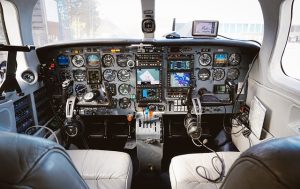
Airplanes may not have gas pedals like those found in automobiles, but they do have rudder pedals. Both the pilot and copilot typically have their own pair of rudder pedals. As the name suggests, these specialized pedals are used to control the airplane’s rudders. For a better understanding of rudder pedals and how they work, keep reading.
What Are Rudder Pedals?
Rudder pedals are foot-operated pedals that, when pressed, control the rudder of an airplane or other aircraft. Airplanes have several hinge-like control surfaces, one of which is a rudder. The rudder is found on the trailing edge of an airplane’s tail assembly. It can swing to the left or right, depending on which rudder pedal is pressed.
Pilots use the rudder pedal to control and mitigate adverse yaw. Adverse yaw is a phenomenon that occurs when an airplane’s nose tilts or yaws in the opposite direction to that in which the airplane is turning. It’s the result of an imbalance between lift and drag. When the wings produce a different amount of lift and drag, the airplane will experience adverse yaw when turning. Using the airplane’s rudders, however, pilots can overcome adverse yaw.
How Rudder Pedals Work
Rudder pedals work by changing the direction in which the airplane’s rudders swing out. Rudder pedals come in pairs. When a pilot presses the left rudder pedal, the airplane’s rudder will swing out to the left. When a pilot presses the right rudder pedal, conversely, the airplane’s rudder will swing out to the right.
Whether a pilot is pressing the left or right rudder pedal, the other rudder pedal will react automatically by raising up. In other words, both rudder pedals can’t be fully raised or fully pressed at any given time. As the pilot presses the left rudder pedal down, the right rudder pedal will gradually rise.
The main purpose of rudder pedals is to control and mitigate adverse yaw, which can occur when an airplane turns or from engine failure. Rudders essentially change the force an airplane’s tail assembly generates. When the airplane’s rudder swings out to the right, the force increases to the right. Pilots can leverage this additional force to overcome and mitigate the effects of adverse yaw.
Rudder Pedals During Crosswind Landings
Pilots may also use rudder pedals during crosswind landings. Crosswind landings involve landing an airplane or aircraft when the wind is blowing at a right angle to the runway. It will typically cause the airplane to drift to the side in which the wind is blowing, which can make it difficult for pilots to safely land.
When landing in crosswinds such as this, pilots will often use the rudder pedals. The additional force generated by the airplane’s rudder will counter the sideways-blowing wing. As a result, pilots can perform crosswind landings more easily.
- SEO Powered Content & PR Distribution. Get Amplified Today.
- PlatoData.Network Vertical Generative Ai. Empower Yourself. Access Here.
- PlatoAiStream. Web3 Intelligence. Knowledge Amplified. Access Here.
- PlatoESG. Carbon, CleanTech, Energy, Environment, Solar, Waste Management. Access Here.
- PlatoHealth. Biotech and Clinical Trials Intelligence. Access Here.
- Source: https://monroeaerospace.com/blog/what-are-rudder-pedals-and-how-do-they-work/



